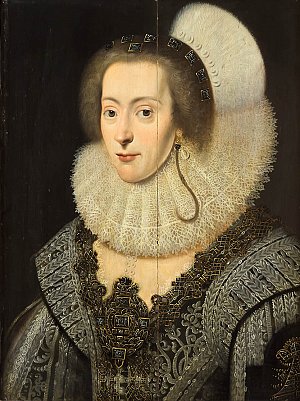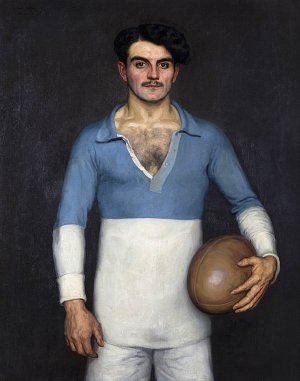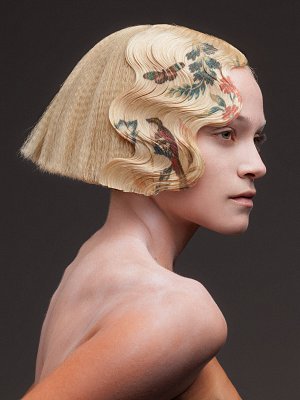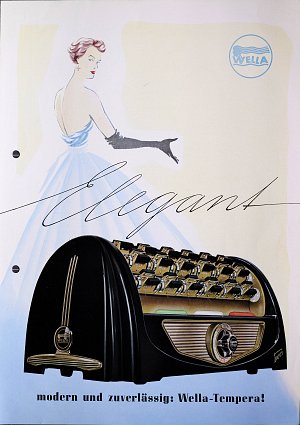In an atmosphere where shades of blond,
brown and red evoke the main hair colors,
the course, divided into five themes,
questions what makes hair, in Greek-
Roman and Judeo-Christian cultures, an
attribute of the animal and wildness and
explains why hair had to be constantly
tamed to remove the woman or man from
the beast.
Fashion and extravagance

Michiel Jansz Van Mierevelt (Delft, 1566 – Delft, 1641), Elisabeth Stuart (1596-1662), quenn of Bohème, old copy, 17th century
Musée Vivant Denon, Chalon-sur-Saône
© Musée Denon / Philip Bernard
The first part of the exhibition opens with
the study of the evolution of feminine
hairstyles, a real social indicator and marker
of identity. In the Middle Ages, obeying the
command of Saint Paul, the wearing of the
veil imposes itself on women until the 15th
century. Gradually, they abandon it in favor
of extravagant hairstyles that are constantly
renewed. In the 17th century, the hairstyle
“to the Hurluberlu” (dear to Madame
de Sévigné) and “to the Fontange” (after
the name of Louis XIV’s mistress) are
emblematic of real fashion phenomena.
Around 1770, the high hairstyles known
as Poufs are undoubtedly the most
extraordinary of Western hair modes.
Finally, in the 19th century, women’s
hairstyles − whether inspired by ancient
Greece, or known as “the giraffe,”
in curls or “the Pompadour” − are just
as convoluted.
To beard or not to beard
After the hairless faces of the Middle Ages,
a turning point occurred around 1520
with the appearance of the beard, symbol
of courage and strength. In the early 16th
century, the three great Western monarchs:
Francis I, Henry VIII, and Charles V were
young and wore beards, which were then
associated with the virile and warrior spirit.
From the 1630s until the end of the 18th
century, the hairless face and the wig were
the hallmarks of courtiers. Facial hair did
not reappear until the early 19th century
with the mustache, sideburns, and beard:
this century was by far the hairiest in the
history of men’s fashion. A multitude
of small objects used (mustache wax,
brushes, curling irons, wax, etc.) testify
to this enthusiasm for mustaches and
beards.

Eugéne Pascau, Fernand Forgues, captain of the Aviron Bayonnais, 1912
Oil on canvas
© A.Arnold Musée Basque et de l’Histoire de Bayonne
During the 20th century, the
rhythm of bearded, mustached, and
smooth faces continued, until the return
of the beard among Hipsters in the late
1990s. The maintenance of hairiness
among these young urbanites has given
rise to the profession of barber, which
had disappeared since the 1950s. Today,
the thick beards tend to give way to the
mustache that had deserted faces since
the 1970s.
The choice of keeping, eliminating,
hiding, or displaying hair on other parts
of the body is also a subject of history
that the exhibition addresses through the
representation of nude bodies in visual arts
and written testimonials. Hairiness is rare,
or even absent from ancient painting. The
hairless body is synonymous with the
antique and idealized body, while the hairy
body is associated with virility, or even
triviality. Only enthusiasts of virile sports
such as boxing and rugby, as well as erotic
illustrations or medical engravings,
show individuals covered in hair.
Around
1910-1920, when women’s bodies were
exposed, advertisements in magazines
touted the benefits of hair removal creams
and more efficient razors to eliminate them.
In 1972, actor Burt Reynolds posed naked,
hairy body for Cosmopolitan magazine,
but fifty years later, an abundance of hair
is no longer in fashion. Since 2001,
sportsmen being photographed naked
for calendars like Les dieux du stade (The
Gods of the Stadium) have had rigorously
controlled hairiness.
Between true and false
Hair styling is an intimate act. Moreover,
a well-born lady could not show herself
in public with her hair down. A painting
by Franz-Xaver Winterhalter, dated 1864,
depicting Empress Sissi in a robe and with
her hair untied, was strictly reserved for
Franz Joseph’s private cabinet.
Louis XIV, who became bald at a very
young age, adopted the so-called “bright
hair” wig, which he then imposed on the
court.

Alexis Ferrer, Wella Professionals Global Creative Artist, Printed Hairpiece, 2021 (collection La Favorite)
© Rafa Andreu Model: Emma Furhmann Agence Blow models
In the 20th century, Andy Warhol
had the same misfortune: the wig he wore
to hide his baldness became an icon of the
artist. Nowadays, hairpieces and wigs are
used in high fashion, during fashion shows
or, of course, to compensate for hair loss.
The natural hair colors and their symbolism
are studied along with what they convey.
Blonde is said to be the color of women
and childhood. Red hair is attributed
to sultry women, witches and some
famous stage women. As for black hair,
it would betray the temperament of brown
and brunettes. From the experimental
colorations of the 19th century to the more
certain dyes from the 1920s: artificial
colors are not forgotten. The work of the
hairdresser Alexis Ferrer who makes digital
prints on real hair is also presented.
Trades and skills
The exhibition reveals the different hair
professions: barbers, barber-surgeons, hair
stylists, wigmakers, ladies’ hairdressers,
etc., through archival documents and
a host of small objects: signs, tools,
various products, and the astonishing
perming machines and dryers of the
1920s.

Wella Tempera, perming device marketing materials, Wella Tempera booklet, 1952
© DR
In 1945, the creation of haute
coiffure elevated the profession to the
rank of an artistic discipline and a French
savoir-faire. 20th century hairdressing
is marked by Guillaume, Antoine, Rosy and
Maria Carita, Alexandre de Paris styling
princesses and celebrities. Nowadays,
great hairstyling is mainly expressed
during the fashion shows of prestigious
fashion houses. Sam McKnight, Nicolas
Jurnjack and Charlie Le Mindu were invited
to the exhibition to create extraordinary
hairstyles for top models and show
business personalities.
A hairy century
Finally, a special focus will allow
us to evoke the iconic hairstyles of the
20th and 21st centuries: the 1900 chignon,
the 1920s garçonne haircut, the 1930s
permed and notched hair, the 1960s
pixie and sauerkraut, the 1970s long
hair, the 1980s voluminous hairstyles,
the 1990s gradations and blond streaks,
not to mention afro-textured hair.

Charlie Le Mindu, Blonde lips, Spring-Summer, Collection 2010 called Girls of paradise, Fashion Week at the Royal Festival Hall, 19 September 2009, London
© Samir Hussein / Getty Images
The arrangement of hair in a particular
form can reveal the belonging to a group
and manifest a political and cultural
expression in opposition to society and the
established order. More ideological than
aesthetic, the Iroquois crest of the punks,
the neglected hair of the grunges or the
shaved heads of the skinheads are strong
moments of hair creativities.
Wearing the hair of another, known
or unknown, has an eerie dimension, and
this superstition seems well-entrenched.
Despite these apprehensions, some
creators choose to transcend this familiar
material into fashion objects. This is the
case of contemporary designers such
as Martin Margiela, Josephus Thimister and
Jeanne Vicerial. The question of identity,
treated lightly or more deeply, is often
at the heart of the reasoning, whether the
hair is real or fake.
The Musée des Arts Décoratifs has
benefited from exceptional loans from
the Château de Versailles, the Musée des
Beaux-Arts d’Orléans, the Musée du Louvre
and the Musée d’Orsay.